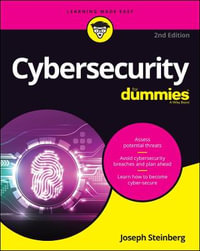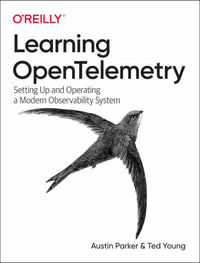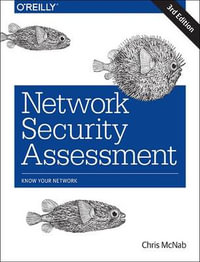
Windows 2000 Virtual Private Networking (VPN)
Paperback | 19 January 2001
At a Glance
384 Pages
22.73 x 15.24 x 2.52
Paperback
$157.75
or 4 interest-free payments of $39.44 with
orAims to ship in 10 to 15 business days
When will this arrive by?
Enter delivery postcode to estimate
For courses in Windows NT/Windows 2000 Networking and Network Security.
Focus on VPNs and security has been created by concerns for privacy and data protection. Learning to configure and maintain VPNs is a necessary skill for CS students. Windows 2000 Virtual Private networking takes into account the emerging distributed workforce that networkers must support, including laptop users, home LAN environments, complex branch offices, and more-all within a secure and effective network design. The way a VPN is implemented in Windows 2000 is different that any other operating system. This book will cover all aspects of both the tunnel server and the tunnel client, covering PPTP, L2TP and IPSec, and the configuration of both tunnel and transport configuration. In addition to specific discussions about Windows 2000 tunneling, the book will show students what a network designer can do with this capability. New VPN features that can affect Active Directory replication, network address translation, Proxy and more will be covered in depth.
| Preface | p. xvi |
| Introduction | p. xviii |
| What Is a Virtual Private Network? | p. 1 |
| History of Virtual Private Networks | p. 1 |
| How a Virtual Private Network Works | p. 3 |
| Alternative Services | p. 6 |
| Transparent LAN Services (TLS) | p. 6 |
| Secure Remote Procedure Call (RPC) Authentication (SRA) | p. 7 |
| Secure Sockets Layer (SSL) | p. 7 |
| Common Uses of Virtual Private Networks | p. 8 |
| Remote Dial-In Users | p. 8 |
| Branch Office Network Links | p. 8 |
| Internal Networks | p. 10 |
| Other Benefits of Virtual Private Networks | p. 12 |
| Summary | p. 12 |
| Basic Virtual Private Network Deployment | p. 13 |
| Terminology | p. 13 |
| Design Considerations | p. 15 |
| Network Access Is Too Expensive | p. 15 |
| Data Security Concerns | p. 17 |
| Methods of Attack on Network Traffic | p. 18 |
| Virtual Private Network Deployment | p. 24 |
| Network Design Concepts with Tunneling | p. 27 |
| Network Infrastructure | p. 27 |
| Network Topology | p. 28 |
| Firewalls | p. 29 |
| Summary | p. 29 |
| VPN Features in Windows 2000 | p. 31 |
| Active Directory | p. 32 |
| PPTP | p. 33 |
| L2TP | p. 34 |
| IPSec | p. 35 |
| Internet Key Exchange (IKE) | p. 37 |
| NAT | p. 37 |
| Connection Manager | p. 38 |
| Certificate Server | p. 38 |
| Dynamic DNS | p. 39 |
| Highly Configurable Network Traffic | p. 40 |
| Easier Router Configuration | p. 40 |
| Summary | p. 41 |
| Point-to-Point Tunneling Protocol (PPTP) | p. 43 |
| How PPTP Works | p. 44 |
| PPP Features | p. 44 |
| Putting the PPTP Basics Together | p. 46 |
| PPTP Encryption | p. 46 |
| PPTP Security | p. 47 |
| Performance Gains | p. 51 |
| Summary | p. 65 |
| Certificates | p. 67 |
| What Is a Certificate Server? | p. 67 |
| Digital Signatures | p. 69 |
| X.509 Version 3 Certificates | p. 70 |
| Certificate Authority | p. 70 |
| CA Trust and Hierarchy | p. 71 |
| Rooted Hierarchies | p. 72 |
| Cross Certification Hierarchy | p. 72 |
| Certificate Enrollment | p. 73 |
| Certificate Verification | p. 74 |
| Certificate Revocation | p. 75 |
| Certificate Storage Model | p. 75 |
| Implementing Certificate Server for Virtual Private Networks | p. 77 |
| Windows 2000 Certificate Procedures | p. 79 |
| Summary | p. 99 |
| Internet Protocol Security (IPSec) | p. 101 |
| IPSec Communication | p. 102 |
| Transport Mode | p. 102 |
| Tunnel Mode | p. 103 |
| The IPSec Driver and the TCP/IP Stack | p. 104 |
| Authentication Header | p. 106 |
| Encapsulating Security Payload (ESP) | p. 107 |
| Application Independence | p. 109 |
| IPSec versus SSL | p. 111 |
| Choosing an IPSec Environment | p. 111 |
| Additional Information About IPSec Tunnel Mode | p. 112 |
| Managing IPSec Policies | p. 113 |
| Bringing the Whole IPSec Picture Together | p. 114 |
| End-to-End Security Between Two Systems in a Domain | p. 119 |
| Creating a Custom IPSec Policy | p. 122 |
| Setting Up an IPSec Tunnel Linking Two Sites | p. 126 |
| Configuring the Destination Gateway | p. 135 |
| Testing and Observing Your IPSec Policy | p. 140 |
| Enable IPSec Logging | p. 142 |
| Creating Many IPSec Policies | p. 143 |
| Summary | p. 144 |
| Layer 2 Tunneling Protocol (L2TP) | p. 145 |
| Goals for Windows 2000 L2TP/IPSec | p. 145 |
| L2TP versus PPTP | p. 146 |
| Transport | p. 147 |
| Authentication | p. 147 |
| Delivery | p. 148 |
| Certificates | p. 148 |
| Address Translation | p. 149 |
| L2TP Implementation Details | p. 150 |
| Security | p. 150 |
| L2TP Communications in Detail | p. 151 |
| Authentication | p. 153 |
| L2TP Encryption | p. 153 |
| Internet Key Exchange Settings | p. 154 |
| Altering Encryption Key Behavior | p. 155 |
| Key Lifetimes | p. 156 |
| Session Key Limit | p. 156 |
| Key Exchange Methods (H3) | p. 157 |
| Main Mode Key Exchange | p. 157 |
| Quick Mode Lifetimes | p. 157 |
| Power Management | p. 158 |
| L2TP/IPSec Procedures | p. 158 |
| Summary | p. 166 |
| NAT and Proxy Servers | p. 167 |
| Proxy Server | p. 168 |
| Application Proxy | p. 168 |
| SOCKS Proxy | p. 169 |
| Proxy Server Functions: Speed and Security | p. 169 |
| Speed | p. 169 |
| Security | p. 170 |
| Disadvantages of Proxy Servers | p. 170 |
| Network Address Translation | p. 171 |
| Advantages of NAT | p. 173 |
| Disadvantages of NAT | p. 173 |
| Firewalls | p. 174 |
| Edge Servers | p. 174 |
| Windows 2000 Network Address Translation | p. 175 |
| Windows 2000 Professional: Internet Connection Sharing | p. 175 |
| Windows 2000 Server: Full-Featured NAT | p. 177 |
| Various Server-Side Network Designs | p. 178 |
| Various Client-Side Network Designs | p. 186 |
| Client-Side Firewalls | p. 187 |
| Client-Side NAT Service | p. 188 |
| Using Hybrid Solutions for Client-Side Connections | p. 189 |
| Maintaining Two Connections at the Remote Office Location | p. 190 |
| Using the Proxy Server as the Tunnel Endpoint | p. 192 |
| Using the NAT Server as the Tunnel Endpoint | p. 193 |
| Nesting Tunnels for End-to-End Security from Remote Networks | p. 194 |
| Summary of Distributed Network Designs | p. 195 |
| NAT and Proxy Server Configuration | p. 195 |
| Setting Up Internet Connection Sharing (ICS) | p. 195 |
| Setting Up NAT with RRAS | p. 199 |
| Sharing a VPN Link | p. 207 |
| Summary | p. 208 |
| Connection Manager, Remote Access Policy, and IAS | p. 209 |
| Connection Manager | p. 210 |
| Using the Connection Manager | p. 210 |
| Requirements | p. 212 |
| Implementation | p. 213 |
| Remote Access Policies | p. 213 |
| Dial-In Properties of a User Account | p. 214 |
| Windows 2000 Remote Access Policy | p. 216 |
| Conditions | p. 216 |
| Permission | p. 218 |
| Profile | p. 219 |
| Remote Access Policies and Windows NT 4.0 RRAS Server | p. 225 |
| Internet Authentication Service (IAS) | p. 226 |
| Windows NT Implementation | p. 226 |
| Windows 2000 Implementation | p. 226 |
| IAS Features | p. 227 |
| Integration with RRAS | p. 228 |
| When Should Your Network Use RADIUS? | p. 228 |
| Installing and Configuring IAS | p. 229 |
| Summary | p. 233 |
| Routing and Filtering | p. 235 |
| Windows 2000 Routing | p. 235 |
| Types of Routing in Windows 2000 | p. 236 |
| Secure Routed Connections | p. 239 |
| Client-Side Routing | p. 240 |
| Default Gateway | p. 240 |
| Invalid Persistent Routes | p. 244 |
| Routing Issues | p. 246 |
| Routing Security | p. 247 |
| Pushing the Envelope with Client-Side Routing | p. 247 |
| Automatic Private IP Addressing (APIPA) | p. 249 |
| Tunnels and Routing | p. 251 |
| Packet Filtering | p. 252 |
| Placing the Tunnel Server in Front of the Firewall | p. 253 |
| Protecting Internal Resources | p. 254 |
| Placing the Tunnel Server Behind the Firewall | p. 256 |
| Summary | p. 259 |
| Name Resolution in Windows 2000 | p. 261 |
| Name Resolution for Tunnel Clients | p. 262 |
| Name Resolution for Home LAN/Branch Office | p. 265 |
| Configuring a DNS for a Home LAN/Branch Office Environment | p. 267 |
| Name Resolution for Disjointed Networks | p. 269 |
| Name Resolution for a VPN-Based Active Directory Environment | p. 271 |
| Happy VPN Networks--A case Study | p. 272 |
| Relationship Between the Branch Office Name Servers | p. 276 |
| Summary | p. 277 |
| Active Directory Design in VPNs | p. 279 |
| Replication | p. 281 |
| The Knowledge Consistency Checker | p. 281 |
| Forcing Replication Manually | p. 284 |
| Urgent Active Directory Replication | p. 284 |
| Single Master Replication and VPNs | p. 284 |
| Optimization | p. 285 |
| Site Design | p. 287 |
| Site Design for VPNs | p. 287 |
| Site Topology | p. 288 |
| Site Topology Components | p. 289 |
| Deploying the AD | p. 291 |
| Mapping IP Addresses | p. 291 |
| Mapping Firewall/NAT IP Ports for Active Directory | p. 292 |
| SMTP Replication | p. 294 |
| Linking Sites with a VPN | p. 295 |
| Conclusions | p. 296 |
| The Happy VPN Model | p. 296 |
| Summary | p. 298 |
| History and Context of Virtual Private Networking | p. 301 |
| The Early Years | p. 301 |
| ISPs | p. 302 |
| Private Networks | p. 303 |
| OSI Reference Model | p. 303 |
| The Physical Layer | p. 305 |
| The Data Link Layer | p. 305 |
| The Network Layer | p. 306 |
| The Transport Layer | p. 306 |
| The Session Layer | p. 307 |
| The Presentation Layer | p. 307 |
| The Application Layer | p. 308 |
| VPN-Related RFCs | p. 308 |
| Troubleshooting | p. 313 |
| Troubleshooting Factors | p. 313 |
| PPTPCLNT and PPTPSRV | p. 315 |
| Performance | p. 315 |
| Common Issues and Troubleshooting Tips | p. 316 |
| Enable Logging on the RRAS Server | p. 317 |
| Troubleshooting IPSec | p. 318 |
| Network Monitor | p. 318 |
| Port Scanners | p. 319 |
| Summary | p. 319 |
| Windows 2000 to Cisco IOS IPSec Connectivity | p. 321 |
| Network Setup | p. 322 |
| Windows 2000 Security Policy Configuration | p. 323 |
| Cisco IPSec Configuration | p. 336 |
| Testing | p. 340 |
| Summary | p. 342 |
| VPN and Network Futures | p. 343 |
| Predicting VPN and Windows Trends | p. 343 |
| Index | p. 347 |
| Table of Contents provided by Syndetics. All Rights Reserved. |
ISBN: 9781578702466
ISBN-10: 1578702461
Series: Circle
Published: 19th January 2001
Format: Paperback
Language: English
Number of Pages: 384
Audience: College, Tertiary and University
Publisher: SAMS
Country of Publication: US
Dimensions (cm): 22.73 x 15.24 x 2.52
Weight (kg): 0.52
Shipping
| Standard Shipping | Express Shipping | |
|---|---|---|
| Metro postcodes: | $9.99 | $14.95 |
| Regional postcodes: | $9.99 | $14.95 |
| Rural postcodes: | $9.99 | $14.95 |
How to return your order
At Booktopia, we offer hassle-free returns in accordance with our returns policy. If you wish to return an item, please get in touch with Booktopia Customer Care.
Additional postage charges may be applicable.
Defective items
If there is a problem with any of the items received for your order then the Booktopia Customer Care team is ready to assist you.
For more info please visit our Help Centre.
You Can Find This Book In

Password Logbook (Hip Floral)
Keep Track of Usernames, Passwords, Web Addresses in One Easy and Organized Location
Hardcover
RRP $19.99
$17.25
OFF

ISC2 CISSP Certified Information Systems Security Professional Official Study Guide & Practice Tests Bundle
Sybex Study Guide
Paperback
RRP $157.95
$109.50
OFF





















